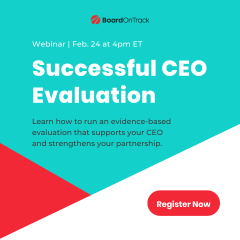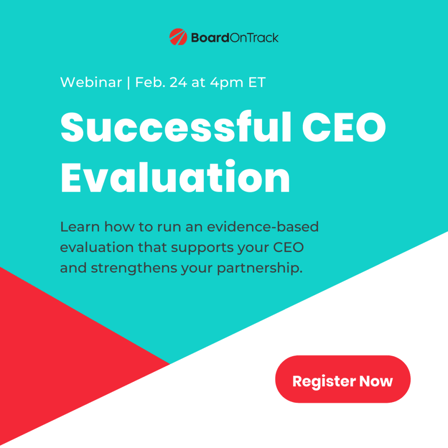The board-CEO partnership is central to the long-term health of any charter school, from pre-doors to emerging CMO. But, it’s also something that both CEOs and board members have to work to learn how to establish and maintain.
Most charter school CEOs come to the role with very limited experience working with boards, if any. And most charter school board members are not educators.
To further complicate things, the CEO’s role seems to become a new job as the organization evolves with each school year. And as the CEO’s role expands, the time available to meet their increasing expectations becomes increasingly limited.
 But nurturing your partnership doesn’t have to be overly complicated. But it does take care and diligence to make your partnership work. And to keep it working over time.
But nurturing your partnership doesn’t have to be overly complicated. But it does take care and diligence to make your partnership work. And to keep it working over time.
“My board does not cause me stress. We have clear roles, good communication. I like them. I see them not only as adding to my own leadership but to the organization’s success. I see them as true partners in our work.”
That’s how Equitas founding CEO, Malka Borrego, describes her partnership with her board.
Similarly, Voices College-Bound Language Academies founding CEO, Frances Teso, says unequivocally, “I feel supported by our board.”
These CEOs have each developed and nurtured a strong board-CEO partnership.
The board and CEO prioritize and professionalize the role of governance.
The board as a whole takes responsibility for governing. Each board member prioritizes their role, putting in the necessary time and attention. And, the board engages in professional development to sufficiently be able to govern.
At the same time, the CEO prioritizes developing and maintaining the board.
In the founding years, the CEO’s relationship with the board might feel more like support than partnership. It might include everything from helping set agendas and pull together packets to the more strategic partnership work of governing the organization.
This should shift over time. Ideally, the CEO’s focus is on ensuring your board has the right people and processes in place, to be your strategic partner and to govern the organization effectively.
The Board and CEO Set Clear, Measurable Goals. And Hold One Another Accountable.
Any partnership can fail if either side thinks they’re not getting what they need from the other.
Both the board and the CEO must have a clear set of goals each year.
Your board’s goals make it clear what the board is going to do to add value to the organization this year. (Learn how to set your board’s goals in our free email course.)
Once finalized, the key is to track those goals throughout the year, and hold individuals accountable to their parts in helping meet those goals. A dashboard like the one in the BoardOnTrack platform makes it easy for the board to hold itself accountable to deliver on agreed-upon goals and tasks.
The same goes for the CEO. An annual set of goals makes clear to the board what you’ll accomplish, and how they’ll measure your progress.
Your board is your partner and your champion. But it’s hard for them to see the big-picture things you’re focused on, what your day-to-day is really like, or how all of that relates to the charter promises that they’ll be held responsible for meeting. The final step in an annual CEO support and evaluation process must be the board and CEO agreeing to clear, measurable goals for the CEO.
The Board and CEO Recognize The Line Between Governance And Management.
The governance-management line is a challenging concept for most charter school governance teams. Board members and CEOs are most likely learning it as they go. And the line shifts as the organization evolves. But a strong partnership requires careful consideration of this line.
The board is clear about the key organizational decisions that need to be made this year, the board’s role in making those decisions, and how it differs from the CEO’s role.
At the beginning of the year, the board and CEO align on the key decisions that will need to be made and clarifies what decisions are within the CEO’s purview.
An Organizational Decisions Chart can help guide you. It clarifies who has responsibility for which parts of your major decisions. And helps you reach a consensus on decision deadlines and level of urgency.
The board and CEO work together at the start of each school year (or during your annual board retreat) to complete the chart. It can then guide the board’s work throughout the year.
The Board and CEO Plan board meetings to allow for necessary communication
A strong partnership depends on good communication. And, considering how limited a board’s time is, this means planning meetings well enough to build in the time needed to communicate and get aligned on strategic issues.
For example: If you need a decision by March 1st on something major, you’ll want to vote at the March board meeting. At the January and February board meetings, you’ll need time to hold substantive and strategic discussions to inform the board’s decision. Preparation for those discussions, then, will happen in December and January.
To make sure you’re using your time strategically and allowing for the right opportunities to communicate:
- Plan your board and committee meetings for the year all at once, and do so around key dates and deadlines
- Reserve enough time for deeper strategy sessions and to build a full understanding of the key strategic issues facing your organization.
- The Board Chair and CEO should carefully plan board meeting agendas together.
Ensure you have substantive board committees delving deeper into key topics in between board meetings. And the committees should partner with CEO — or their staff designee — to own and present their work.
The Board and CEO Make Decisions Based on Data, Not Assumptions.
Even with clear goals and decision-making processes, the partnership can still break down if decisions are driven by feelings or assumptions rather than data.
Imagine that one person feels like a discipline policy is too strict, others not strict enough. Discussions driven by feelings, opinions, and assumptions, can seem to swirl endlessly. Data-driven decisions are your way out of that swirl.
Are you preparing to discuss a change to how you’re allocating things in your budget? Decide what data will show that spending the money in a different way is going to get you better outcomes for kids.
Generally, providing that data falls to the CEO. But the board and CEO agree upfront about what data is important, relevant, and attainable.
The Board and CEO Establish Succession Plans
It’s essential to have a succession plan for the CEO and the board.
Most boards wonder what would happen if they lost their CEO. A lot of charter schools are launched around the lead founder. A CEO transition, especially transitioning from the founding CEO, is the greatest test of the strength of your governance team.
When succession planning is a regular part of your partnership, you’re prepared for the hard discussions. Your CEO can come to your board chair a year (or even two) in advance of a departure, ready to openly discuss guiding the organization through to that next chapter. Your board officers don’t feel like they’ll have to serve in their roles forever, because they don’t know how to pull in the next person to lead the team.
The Board and CEO Consistently run an effective CEO evaluation
Even if you’ve never led a true CEO evaluation before, any time is a great time to start developing and adopting your process. And it can be a great way to start the new school year off on the right foot.
Make sure you follow a year-round CEO support and evaluation process. In fact, you should have a CEO Support & Evaluation Committee in place to lead the process.
Data in our first-ever charter school CEO compensation study shows even more strongly how important this process is. We’ve found correlations between this practice and the strength of the partnership, the level of CEO compensation, and even a CEO’s likelihood to leave their role.



